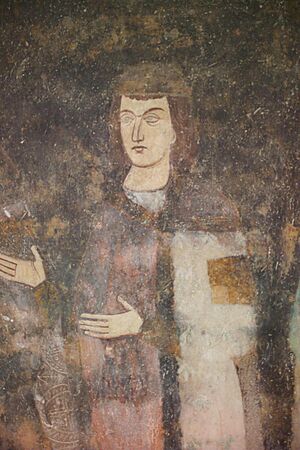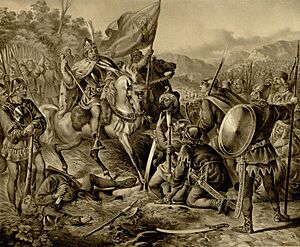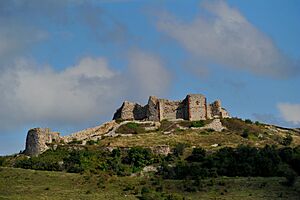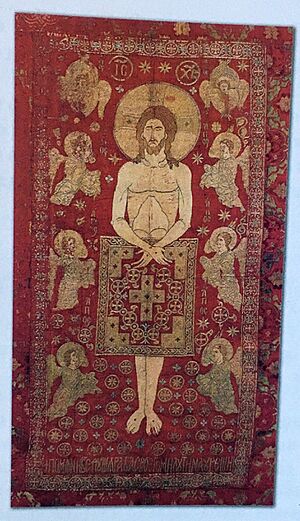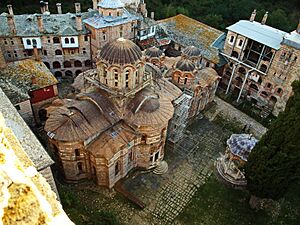Stefan Milutin facts for kids
Quick facts for kids SaintStefan Uroš II Milutin Стефан Урош II Милутин |
|
|---|---|

King Milutin, founder's portrait (fresco) in King's Church of the Studenica Monastery, painted during his lifetime, around 1314
|
|
| Milutin the Ktetor | |
| Born | 1253 |
| Died | 29 October 1321 (aged 68) |
| Venerated in | Eastern Orthodox Church |
Stefan Uroš II Milutin (born around 1253 – died October 29, 1321) was a powerful King of Serbia. He ruled from 1282 to 1321 and was a member of the Nemanjić dynasty. Milutin was one of the most important rulers in Serbia in the Middle Ages. He helped Serbia become very strong, especially by developing silver mining. He founded Novo Brdo, which became a famous silver mining town. Like many other Nemanjić kings, he is considered a saint by the Serbian Orthodox Church.
Contents
Becoming King and Early Wins
Milutin was the youngest son of King Stefan Uroš I and Helen of Anjou. He became king unexpectedly when his older brother, Stefan Dragutin, stepped down. Milutin was about 29 years old when he took the throne.
Right away, he started to expand Serbia's territory. In 1282, he took control of northern Macedonia, including the city of Skoplje. Skoplje then became his new capital city. The Byzantine Emperor, Michael VIII Palaiologos, planned to fight back, but he died before he could. The next year, Milutin and his brother went even deeper into Byzantine lands.
In 1284, Milutin also gained control of northern Albania and the city of Dyrrachion (today called Durrës). After many years of fighting, peace was made in 1299. Milutin kept the lands he had conquered. This was part of the marriage agreement when he married Simonis, the daughter of Emperor Andronikos II Palaiologos. She became his fourth wife.
Battles with Neighbors
At the end of the 1200s, two Bulgarian lords, Darman and Kudelin, ruled the Braničevo region. They often attacked the lands of Milutin's brother, Stefan Dragutin. Dragutin and his ally, Queen Elizabeth of Hungary, tried to defeat them but failed.
Finally, in 1291, Milutin and Dragutin joined forces. They defeated the Bulgarian lords, and Braničevo became part of Serbia for the first time. This made another Bulgarian prince, Shishman of Vidin, angry. Shishman was a vassal of Nogai Khan, a powerful Mongol leader. Shishman began to attack Serbian lands.
Milutin fought back, defeating Shishman and taking control of his lands. Shishman had to flee across the Danube River. Later, Milutin and Shishman became allies. Milutin even arranged for his daughter, Neda (also called Anna), to marry Shishman's son, Michael Shishman of Bulgaria. Michael later became the Tsar of Bulgaria.
Milutin also had a conflict with the Mongol leader, Nogai Khan. To make peace, Milutin sent his son, Stefan Dečanski, to Nogai's court. Stefan stayed there until Nogai Khan died in 1299.
Serbia's Power and Economy
Image:Kingdom of Serbia at the end of the XIII century and early fourteenth A.svg Milutin's rule saw Serbia's economy grow very quickly. This was mainly because of new mines, especially in the Kosovo area. During his time, Novo Brdo became the richest silver mine in the Balkans. Other important mines were Trepča and Janjevo.
Milutin even made his own coins, which were similar to Venetian coins. They had a lot of silver in them. Even though Venice banned them, Milutin used these coins to help his kingdom. By the 15th century, Serbia and Bosnia together produced more than 20% of all the silver in Europe.
In 1312, Milutin sent Serbian troops to help the Byzantine Emperor fight against the Turks. The Serbs helped defeat the Turks at the Battle of Gallipoli (1312). As a thank you, the town of Kucovo was given to Serbia.
After his brother Stefan Dragutin died in 1316, Milutin took control of most of Dragutin's lands, including Belgrade. This caused problems with King Charles I of Hungary. There were also some disagreements with Catholic leaders and local nobles during his reign.
In 1314, Milutin's son, Stefan Dečanski, rebelled against him. Stefan was captured, blinded, and sent away to Constantinople. For a while, Milutin's youngest son, Stefan Constantine, was expected to be the next king. But in 1321, Stefan Dečanski returned to Serbia and was forgiven by his father.
Family Life
King Stefan Uroš II Milutin was married five times.
- With his first wife, Jelena, he had a son:
- King Stephen Uroš III
- With his second wife, Helena, he might have had:
- King Stefan Konstantin
- With his third wife, Elizabeth, he had:
- Anna, who married Michael Asen III of Bulgaria
- Zorica
- His fourth wife was Anna. They probably had no children.
- His fifth wife was Simonis. They had no children.
Legacy and Buildings
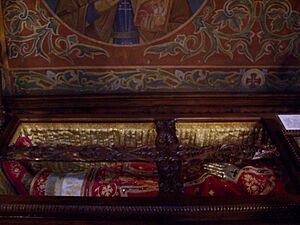
By the end of Milutin's life, Serbia was one of the strongest countries in Southeast Europe. Many customs from the Byzantine court were adopted in Serbia during his reign. After he died, there was a short period of conflict. His eldest son, Stefan Dečanski, eventually became king.
Around 1460, King Milutin's remains were moved from the Hilandar monastery to Bulgaria. They were kept in different churches and monasteries before being moved to the St Nedelya Church in Sofia. His remains are still there today, and the church is sometimes called "Holy King" because of him.
King Milutin is remembered for building many churches and monasteries. He also founded a hospital in Constantinopole, which later became a medical school. He was known as a ktetor, which means someone who builds or donates to churches and monasteries.
Churches and Monasteries Founded by Milutin
- Vitovnica Monastery near Petrovac, Serbia (1291)
- Church of St. Nicetas in Banjane, North Macedonia (around 1300)
- Our Lady of Ljeviš in Prizren (1306–1307)
- The King's Church of the Studenica Monastery in Kraljevo, Serbia (1313–1314)
- Church of St. George in Kumanovo, North Macedonia (1313–1318)
- Banjska Monastery near Zvečan (1318)
- Gračanica Monastery in Gračanica (1321), which is now a UNESCO World Heritage Site.
Churches and Monasteries Rebuilt by Milutin
- Monastery of Saints Sergius and Bacchus near Shirq (1293)
- Church of the Virgin Hodegetria in Mušutište (1314—1315)
- Church of Entrance of the Theotokos of the Hilandar Monastery at Mount Athos, Greece (1320)
- Church of St. Peter near Bijelo Polje, Montenegro (1320)
See also
- Nemanjić family tree
- History of Serbia
Images for kids
-
Gračanica Monastery, today a UNESCO World Heritage Site
|
Stefan Milutin
Born: 1253 Died: 29 October 1321 |
||
| Regnal titles | ||
|---|---|---|
| Preceded by Stefan Dragutin |
King of Serbia 1282–1321 |
Succeeded by Stefan Dečanski |


